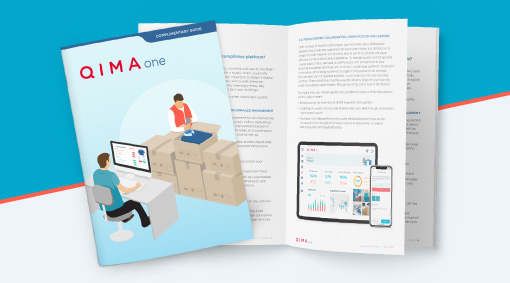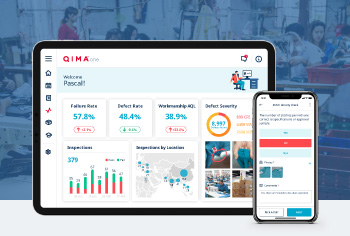
Articles
3 practical steps to start your quality 4.0 transformation journey!

Articles
3 practical steps to start your quality 4.0 transformation journey!
Articles
3 practical steps to start your quality 4.0 transformation journey!

Keep up-to-date with the latest supply chain insights.
According to an article published in The Journal of Intelligent Manufacturing, Quality 4.0 is the term coined to reference the push for performance excellent in an age of digital transformation. The “4.0” in the term is drawn from the understanding that we live in a fourth Industrial Revolution, which some commentators have taken to calling simply “Industry 4.0.” While previous Revolutions were powered by developments in steam machines, electricity, and telecommunications, the Fourth Industrial Revolution was birthed from big data, advanced manufacturing techniques, interconnectedness, machine learning, and artificial intelligence.
The reporting of live data offers a transparency that production facilities have never experienced before, especially when distributed around the globe. The improved use of data allows companies to be more proactive in how they deal with quality issues or outside circumstances, granting an agility that optimizes equipment and human resources.
As the advances of Quality 4.0 become more readily available, companies must reckon with these new technologies to be successful. They must implement a platform to enable smoother collaboration between brands, factories and suppliers. This collaboration improves quality control and supply chain visibility, resulting in more secure profit margins and increased customer satisfaction. Companies will adopt smarter tools and processes to take advantage of Quality 4.0, or they will be left behind.
Quality 4.0: The power of data
There are three important factors at work as a result of the technological developments behind Quality 4.0. First, data has become a cornerstone of operations as it became easier to collect, organize, and analyze. Second, technology enables collaboration with factories and suppliers to act upon the data. Third, Quality 4.0 principles facilitate higher margins and increase customer satisfaction.
A core element of Quality 4.0 is the quick collection of large amounts of data and its efficient processing. Successful Quality 4.0 solutions place data at the core of all their decisions. When companies maintain the traditional methods, quality control managers are forced to rely on information that is disparate and outdated.Quality control managers could never be certain of the accuracy of that data, given it was so dependent on collection practices by suppliers that relied on pen and paper measurements with so much room for human error. Data collection was slow, accessing it even slower, and bringing it together to form a complete, accurate picture nearly impossible. Modern quality practices have enabled new ways to process and access information about production and distribution.
Quality 4.0 puts technology to work for managers and empowers inspectors in factories to make accurate observations efficiently. According to a recent survey conducted by LNS Research, 37% of organizations report that poor metrics are the main challenge to achieving quality objectives. New quality management technology helps select and enact standardized metrics for each of a company’s individual products. The flow of information provided by new technology facilitates the communication that makes partnership possible.
When companies have better relationships with their suppliers and factories, those efficiencies result in the better overall margins that result from fewer quality problems and a more responsive supply chain. With fewer defective products in the hands of consumers, customer satisfaction improves, which in turn results in more business. According to a 2019 survey conducted by Deloitte, factories saw a rise in their Key Performance Indicators—an increase as large as 12%—after adopting Quality 4.0 technologies between 2015 and 2018. Those kinds of returns would rightly get everyone’s attention.
The use of data through Quality 4.0 practices allows for better production at a better cost, and better products available to happier customers. Where quality practices used to involve manual processes that were slow and ripe with opportunities for error, Quality 4.0 smooths communication to facilitate accurate, actionable, automated feedback for a company’s decision-makers.
Quality 4.0 reconnects brands and suppliers
Additionally, Quality 4.0 makes communication and connection easier. As the world’s supply chain learned during the COVID-19 pandemic, situations and circumstances can change quickly. That makes it vital that decision-makers have good information fast so they can pivot as necessary.
Quality is especially important in the apparel industry. Each defective product represents a loss of time and materials. Returns are extremely costly to apparel manufacturers; often, the cost of a return is greater than the cost of making the item in the first place. Common garment defects, like poor stitching or inaccurate sizing, could be identified with a more modern quality plan before they reach the marketplace.
Ensuring that only quality products reach consumers is of vital importance to the continued viability of an apparel manufacturer. When defective products enter the marketplace, companies run the risk of ruining their reputation and scaring off potential future customers. Modern consumers are quick to change their preferred brands when faced with poor quality. Furthermore, unhappy customers will voice their displeasure in public forums. Since more and more consumers start their purchasing decisions by researching online reviews, manufacturers are well-served by taking the steps necessary to prevent defective merchandise from reaching customers.
Putting Quality 4.0 to Work
There are three steps to take to begin your company’s move into Quality 4.0.
Step One
The first step in implementing Quality 4.0 is to identify an appropriate Quality Management System (more on that in a bit). The QMS you select should come from a software developer who understands your business and can help you ensure that your processes are efficient and complete. They’ll be a partner in gathering the data you need to develop improvements where necessary and to empower suppliers to enact productive changes.
Ideally, the QMS you choose should be strong on two levels. First, the technology should be solid and security-proven: stable, intuitive, and backed by tech support that understands you operate around the world. Second, the company should understand supply chain, compliance, and quality management, and have built their QMS on a foundation of understanding what quality practices look like, in real world factories, with real world products being made by actual people.
Step Two
Because one of the biggest hurdles to properly implementing Quality 4.0 practices is employee and supplier training, implement the necessary workshops and educational programs before putting the QMS technology in place.
Your software supplier must offer a rigorous training program with continued support beyond initial installation. This begins with the design of the QMS. It should be intuitive, cross-cultural, and customizable. Your software should take advantage of what quality control experts know about functional checklists and defect lists.
Software training must be available for every level of a business’s operations. In particular, your on-the-ground workers in the factory must receive training on the software, plus the current industry-proven quality assurance standards. With the right training and the right tools, factory workers are empowered to better monitor for quality lapses. Additionally, they’ll increase efficiency, and their autonomy will encourage higher standards.
Through training and cooperation, you’ll be able to take advantage of a higher level of trust up and down your supply chain, using a quality QMS to maintain connection throughout the manufacturing and delivery process.
Step Three
Finally, the last step of implementing Quality 4.0 is the commitment to putting it in action at every stage of manufacturing. Plan to implement Quality 4.0 technology and practices across the entire length of your supply chain. Defective products, especially in the apparel industry, are so expensive that, as explained at TotalRetail, one return of a $50 pair of shoes could eat-up the profit made from as many as three successful sales. If quality management is only implemented at the end of production—as is often the case—then you miss the opportunity to catch defects well before the materials even get the chance to become your product.
In the early stages, Quality 4.0 practices should be applied to recognized pain points within your system. That allows for the adoption of metrics and tests that are most-easily evaluated, and could have foundationally large impact on your overall performance. Then you can scale up your practices, returning to employee development as needed, and Quality 4.0 technology is put into place in a widening range of your facilities. Management uses the new data to continue developing strategies that match the overall company vision, while partners up and down the network are empowered to take ownership of quality outcomes.
The result is a culture of quality, built on communication, trust, transparency, and resilience.
Perform easy self-inspections
with your factories
Learn more!

Perform easy self-inspections
with your factories
Learn more!
Quality Management Systems and Quality 4.0
A robust, modern quality management system enables you to leverage the advances in Quality 4.0. Stressing the seamless interconnectedness of the Fourth Industrial Revolution, a Quality 4.0 QMS produces clean, clear reports from technologically-assisted inspection results, and transmits them to management in real-time. The true secret to the power of Quality 4.0 is the accuracy of that data and management’s ability to use it—quickly—for analysis, problem-solving, and strategic planning. If your QMS doesn’t give you standardized yet customizable metrics and reporting, your business is missing out on everything Quality 4.0 has to offer.
Though the conduit for Quality 4.0 is the technology, it’s still in the hands of workers. High-standard QMS providers include training as part of an overall package. Their customer service is as important as yours. Seek QMS providers that offer robust on-boarding and then sustained training that addresses changes in the technology, changes in the market, and changes in your business’s needs.
In a survey published recently by business consultation experts BCG, 74% of their respondents reported that Quality 4.0 developments will most-benefit manufacturers. Nearly two-thirds of their respondents stated that Quality 4.0 initiatives will have a significant impact on their businesses within five years. However, only 16% of them reported their companies have begun implementing these initiatives.
Smart factories using digital tools experience measurable increases in quality and productivity and a result of their flexibility and ability to respond to situations quickly. In fact, all levels of production and distribution can take advantage of Quality 4.0 practices. That offers incredible opportunity for businesses who are ready to make the leap forward, ahead of their competition. Partnering with a Quality 4.0 QMS provider can jumpstart a business’s modernization efforts.
Quality 4.0 and the QIMAone Software Platform
The QIMAone software platform has everything your business needs to push forward into the Quality 4.0 experience.
The robust technology offers on-site inspectors the ability to take accurate measurements based on you and your products’ needs. QIMAone then generates reports in real-time, and makes them accessible to decisionmakers around the globe. Since one of the keys to Quality 4.0 is seamless communication, the QIMAone QMS ensures that your team remains in contact no matter what the circumstances are on the ground.
Additionally, QIMAone includes a true partnership with a supply chain expert that brings decades of quality control and assurance work to your manufacturing processes: innovation coupled with experience and industry-leading training that remains accessible throughout your use of QIMAone. Regardless of what you’re making, where you’re making it, and where you’re moving it to, QIMAone helps you ensure that your products are high quality, produced with ethical and environmental standards, and brought to market as efficiently as possible.
If you’re ready to get a head start on the competition and begin your journey into Quality 4.0, click here today
Most Popular Articles
Corrective Action Plans 101: Your Basic Guide to Ensuring Supply Chain Quality Excellence
The Benefits of a Data-Driven Supply Chain
6 Benefits of Supply Chain Visibility
How to Implement a Quality Management System
Simpli Home: Ensuring product quality and compliance with supply chain technology
7 Effective Ways to Improve Your Quality Management System
Supply Chain Visibility: Complete Guide for Supply Chain Managers
Boost Quality Control with Supplier Performance Metrics















